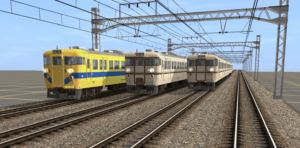
From left to right: 113 Series in the old Fukuchiyama Line livery, 113 Series and 115 Series in the new one.
DOWNLOAD
This is a reskin of Keinchiro’s 113 Series upgraded by Hirochi. All the necessary dependencies are included in this package or are avaible on the DLS.
In case of missing dependencies, download this.
113 Series trains were introduced on the Fukuchiyama Line in 1986, when the final section of the line (Takarazuka to Fukuchiyama) was double-tracked and electrified, enabling the Fukuchiyama Line to operate as an unified and indipendent line.
Before that, the electrified Takarazuka to Amagasaki section operated as a Tokaido Main Line branch (with through-services), while the non-electeified Takarazuka to Fukuchiyama section operated separately with DMUs.
The 113s introduced on the line were formed in -3 and -4 car sets, fitted in a distinctive, eye-catching yellow and blue livery, very similar to the one carried by Fukuen Line 105 Series trains in Hiroshima. The rationale behind this particular livery was to make the trains more visible in case of snow.
This particular livery was not well recieved, by railwaymens and commuters alike; actually, it was particularily disliked, as it made the 113 Series look like a maintainance or work train (in fact, the Shinkansen “Doctor Yellow” inspection train used a very similar color scheme with identical tonalities!), reason why, after just four years, the Fukuchiyama Line trains were repainted into a new livery by the newly-formed JR West (wich had taken over from JNR when it was privatized in 1987).
The new Fukuchiyama Line livery was cream with brown and green lines, a particular yet elegant combination, wich fully replaced the disliked older one by 1990.
At the same time, the Fukuchiyama Line saw a sharp rise in ridership; as such, a new train was needed.
The 207 Series was JR West’s first commuter train design, intended to replace the older 103 Series trains on commuter services. Not casually, the first line to get the new trains was the Fukuchiyama Line, wich was also to be connected to the under-construction underground JR Tozai Line (over wich the older stock couldn’t run).
The first 207 Series sets entered service on the Fukuchiyama Line in 1991, replacing the 103 and 113 Serieses, with where surplus sets of the latter to be converted to AC/DC operation and transferred to the Nanao Line in Ishikawa Prefecture.
Due to a few delays in deliveries of the 207 Series, the converted 113 Series (now reclassified as “415-800 Series”) had to temporarily return in service on the Fukuchiyama Line, alongside a few 115 Series sets that had been transferred from less utilized lines to temporarily reinforce the Fukuchiyama Line fleet until enough 207 Series trains where phased in.
By the early 2000s, there were finally enough 207 Series trains to replace the older stock, and the 113 and 115 Series were retired in 2004, with most of the older trains being transferred to Shimonoseki and Okayama depots for use on the San’yo Main Line.
Just one year later, on the 25th of April 2005, a 207 Series overspeed trough a very tight curve (the driver was trying to make up a few minutes of delay to avoid being repimanded), derailed and crashed into a building.
This incident, wich became sadly known as the Amagasaki Derailment had been caused by JR West itself, having pushed the line’s schedules to the limit (the Fukuchiyama Line largely parallels, and competes with the fierce Hankyu Railway Takarazuka Line), and employed harsh penalties (“Nikkin Kyuko”) for those that failed to keep up with those extremely tight schedules.
Besides having to face (the deserved) backlash, JR West had also to cope with the fact that the accident could’ve been easily avoided if the 207 Series trains had been fitted with the ATS-P saftey system – in fact the 207 Series wasn’t fitted with any train protection system (except for the Dead Man’s Swithch) at all!
Faced with this, JR West was forced to take out of service all 207 Series trains and temporarily replace them with ATS-P-fitted stock; as such, a large number of 113 and 115 Serieses trains previously displaced to regional and local lines had to be called back to Osaka area lines, as they were already fitted with ATS-P.
Even former Fukuchiyama Line trains that had been replaced in 2004 were returned to the Fukuchiyama Line, but as they had been refurbished, they lost their cream-brown-green livery for JR West’s “Café au Lait” livery, wich was standard for refurbished 113s and 115s.
With the rest of the remaining 207 Series fleet being retrofitted with ATS-P, and the introduction of 321 Series trains, all the remaining 113 and 115 Serieses trains were replaced by 2012.
113 and 115 Series Mixed Consists download page
